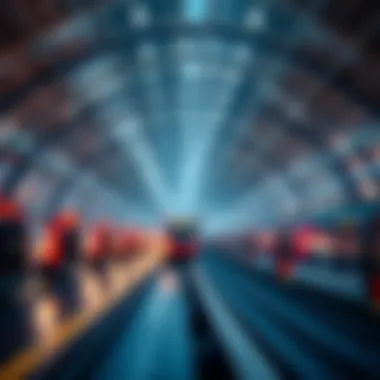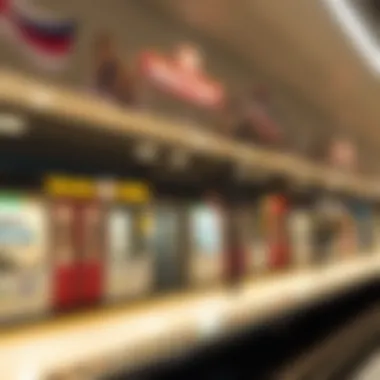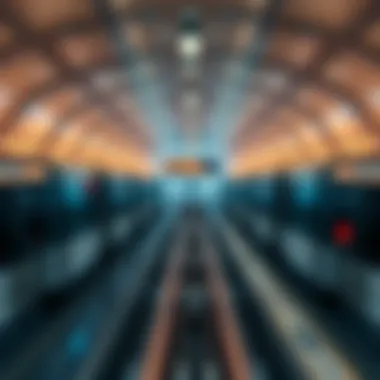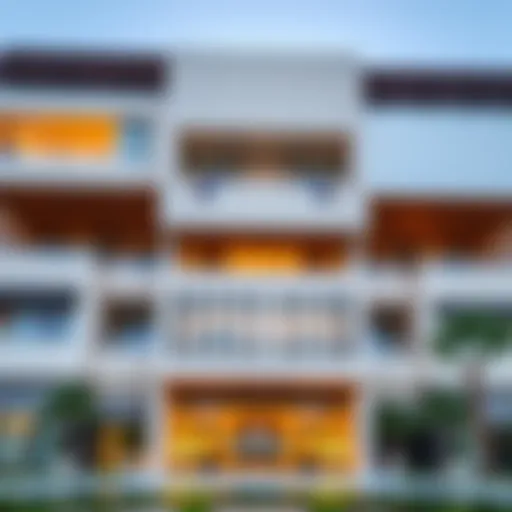In-Depth Look at the Dubai Metro Chart and Its Impact


Intro
The Dubai Metro system is more than just a series of train lines; it’s a reflection of the city’s rapid growth and its aspirations for a connected future. This intricate network serves as a lifeline, linking neighborhoods and facilitating easy movement for residents and visitors alike. As the city continues to bustle and evolve, understanding the metro chart becomes imperative not only for daily commuters but also for investors and stakeholders in the real estate market.
With its modern design and efficient operations, the metro has reshaped the way people navigate across Dubai. What’s even more compelling is how its routes intertwine with various neighborhoods, making some areas more desirable for living and investment than others. In this article, we will chronicle the key elements that define the metro system, explore its impact on property values, and speculate on future developments that promise to enhance this vital urban infrastructure.
By the end of this analysis, you will have a deeper understanding of the relationship between the metro and the property market, thereby equipping you with the insights necessary to make informed decisions as a buyer, seller, or investor in Dubai’s dynamic landscape. Let's take the first step together into the world of Dubai’s metro, starting with an overview of the property market.
Property Market Overview
The real estate sector in Dubai is both dynamic and complex, shaped significantly by various factors, including access to the metro system. The connectivity provided by the metro influences property values, making certain areas more attractive.
Current Market Trends
In recent years, there has been a noticeable shift in the property market with rising investor interest particularly in areas adjacent to metro stations. As urban development progresses, the demand for residences near metro lines has surged.
- Increased Rental Yields: Properties close to metro stations tend to have higher rental yields, making them a popular choice for investors.
- Affordable Luxury: Emerging neighborhoods are offering what some call 'affordable luxury,' catering to a demographic keen on modern amenities and accessibility.
- Sustainable Living: There’s an increasing preference for eco-friendly and sustainable urban living, and the metro system fits perfectly within this trend, providing a greener transportation alternative.
These trends showcase how the synergy between urban transport and real estate can be a game changer for both residents and investors.
Key Neighborhood Insights
Certain neighborhoods around Dubai Metro stations stand out for their unique characteristics and investment potential.
- Dubai Marina: Known for its vibrant atmosphere and waterfront views, properties in Dubai Marina maintain a high demand due to their proximity to the metro.
- Downtown Dubai: Home to the iconic Burj Khalifa, residents enjoy a bustling lifestyle with seamless metro access, making it highly desirable for both buyers and renters.
- Jumeirah Lakes Towers: With various amenities nearby, it's an emerging area that caters to professionals and families alike, bolstered by the metro’s accessibility.
Understanding these neighborhoods and how they relate to the metro chart is essential for capitalizing on opportunities and ensuring informed investments.
"Access to the metro not only enhances convenience but directly correlates with increased property value and desirability among buyers."
As we transition into the next phase of our discussion, the focus will shift towards buying and selling guidelines, ensuring that you are fully equipped to navigate the market effectively.
Prelims to the Dubai Metro
The Dubai Metro stands not merely as a transit system, but as a cornerstone of urban mobility and development in the city. Since its inception, it has transformed not only how residents and tourists navigate Dubai but also how the city itself is structured and grown. In this article, we will dive into the details of the metro system, emphasizing its significance, benefits, and the broader context within which it operates.
Understanding the metro is crucial for multiple stakeholders, including investors, property buyers, real estate agents, and developers. The metro influences various aspects of daily life in Dubai, from commute times to property valuations. Its stations serve as focal points for urban development, linking vital neighborhoods and commercial areas. The integration of the Dubai Metro into the city’s infrastructure has provoked significant considerations for planning and investment as urban spaces evolve.
The Genesis of the Dubai Metro
The genesis of the Dubai Metro is tied to the city’s rapid growth and need for modern transport solutions. Initiated in the early 2000s, the project stemmed from Dubai's ambition to create a world-class public transport system that would alleviate traffic congestion and provide efficient transport options. The first phase launched in 2009 with the Red Line, stretching from Rashidiya to Jebel Ali, covering some of the city’s busiest districts.
The metro project faced numerous challenges, including financial investments, engineering hurdles, and the need for advanced technology. Yet, these challenges became stepping stones for achieving what many view today as a modern marvel. The Dubai Metro incorporates state-of-the-art technology, ensuring safety, efficiency, and convenience for its users. Its driverless trains showcase advanced automation, emphasizing Dubai's commitment to innovation. The successful launch not only fulfilled a transport need but also catalyzed urban development around its stations, making it a pivotal piece of the city’s growth strategy.
Overview of the Metro System
The Dubai Metro system boasts a sophisticated structure designed to serve both residents and visitors effectively. With two main lines—the Red Line and the Green Line—the metro connects key areas of Dubai, facilitating travel across significant residential and commercial hubs.
Currently, the metro features:
- Multi-modal Integration: Seamlessly linking the metro with other transport systems like buses, taxis, and water taxis.
- Smart Technology: RFID cards for easy access and refined user experience, as well as real-time updates on train schedules through various digital platforms.
- Accessibility Features: Dedicated facilities for individuals with reduced mobility, ensuring inclusivity.
The Dubai Metro's chart not only simplifies transit planning but enhances the user experience by providing clear, accessible information on routes and schedules. With frequent services, the metro alleviates the burden of road traffic, enabling faster commutes and offering a dependable alternative to driving.
The expansion plans are in the pipeline, indicating that the metro system is set to adapt to the growing needs of a dynamic city. This evolution leads to enhanced connectivity, better access to opportunities, and, ultimately, rises in property values in proximity to metro stations. The ongoing development is an embodiment of Dubai’s vision for a sustainable and interconnected urban environment.
The Dubai Metro is not just about transportation; it's a driving force behind real estate trends and urban development in the region.
The ongoing discussion and analysis surrounding the metro chart is crucial. It touches upon the strategic movements in real estate and investment and impacts how individuals and businesses navigate the dynamic landscape of Dubai.
Understanding the Metro Chart
Grasping the metro chart in Dubai is crucial for anyone involved in the real estate market or regular urban navigation. The chart isn't just a depiction of lines and stops; it serves as a graphical representation of the connectivity that defines how residents and investors interact with the city. Understanding this chart sheds light on essential factors like accessibility, nearby amenities, and potential property value implications.
Having a good grasp of the metro chart influences investment decisions, as investors can identify which areas may yield better returns based on transport accessibility. Additionally, it helps residents in daily commuting, making their journeys more efficient. As Dubai continues to grow, the importance of a well-structured transport system like the metro cannot be overstated.


Components of the Metro Chart
The metro chart comprises several key components that collectively illustrate the extensive network of Dubai's rail transit system. At first glance, the chart may appear complex, but breaking it down reveals the clarity behind its structure. Here's a look at its primary elements:
- Metro Lines: The chart prominently features various metro lines, each distinguished by different colors. The two main lines, the Red and Green lines, are the backbone of the system, connecting pivotal areas across the city.
- Stations: Every segment of the lines is lined with station markers, which indicate stops where passengers can board or disembark. Some stations are classified as interchange stations, where lines meet, offering greater connectivity.
- Zones: The map may also depict fare zones that delineate fare structures based on distance traveled. Each zone's boundaries are essential for knowing how much one might expect to pay for a journey.
- Landmarks: Noteworthy sites such as shopping malls, hospitals, and cultural attractions are marked, assisting riders to navigate more effectively to their destinations.
- Accessibility Features: The chart often highlights elevators and escalators, ensuring that all passengers, including those with mobility challenges, can access the metro without barriers.
With these components in the picture, users can quickly adapt to the system and utilize its benefits.
Interpreting Metro Lines and Stops
Understanding the intricate relationship between metro lines and their stops is pivotal when navigating the city. The lines represent the routes that connect distinct geographical areas, while the stops signify strategic locations that allow commuters to hop on and off with ease. Here are some critical insights:
- Route Planning: Each line is designed to not just connect key regions but also facilitate commuting for daily workers, tourists, and residents alike. For example, the Red line stretches from Rashidiya in the east to Umm Al Ramool in the west, servicing the commercial and leisure hubs along the way.
- Frequency of Service: The chart often reflects the frequency of trains during peak and off-peak times, essential information for commuters considering travel times.
- Connections to Other Transport: Interchange stations play a significant role as they allow travelers to transition from metro to bus or tram services, making comprehensive urban travel smoother.
- Preparing for Expansions: As more stops are planned in upcoming expansions, understanding the current chart can help in predicting future growth areas. Keeping an eye on potential developments in transport hubs can offer valuable insights into future property investments.
In essence, interpreting the metro lines and stops provides a roadmap for navigating the bustling streets of Dubai efficiently, making it easier for residents to integrate into the city's fast-paced lifestyle.
"A well-designed metro chart is like the city’s pulse, guiding investments and daily commutes seamlessly."
For further detailed reading on the Dubai Metro, you might visit the official RTA or Wikipedia page.
Metro Lines and Routes
The Dubai Metro is not just a transportation system; it reshapes the urban landscape, influencing everything from property values to lifestyles. Understanding the metro lines and routes is crucial, as they form the backbone of daily commutes for residents and offer the potential for investors looking to capitalize on real estate opportunities.
The metro lines play a pivotal role in connecting various parts of the city, making areas previously deemed distant more accessible. This increased connectivity is a double-edged sword; while it brings neighborhoods closer, it also elevates the desirability of properties near metro stations. Notably, both the Red and Green lines cater to diverse demographics—tourists, business professionals, and families alike—enhancing choice and convenience in urban travel.
In examining specific elements of the metro lines, one must consider the strategic placement of stops, which often correlate closely with significant economic and cultural hubs. This correlation highlights the benefit of investing in properties near these stations. For instance, locations like the Burj Khalifa/Dubai Mall station attract both local and international visitors, making adjacent real estate particularly appealing.
However, it’s important to take into account some considerations as well. Increased traffic could lead to congestion in surrounding areas and affect the daily life of current residents. Urban planners and investors must balance this growth with the need for sustainable practices.
"Metro not only shapes the physical landscape but also influences the economic tide of neighborhoods, making it a vital player in Dubai’s urban narrative."
The Red Line: Key Highlights
The Red Line stands as a cornerstone of the Dubai Metro network, stretching from Rashidiya to UAE Exchange. Spanning approximately 52 km, it provides vital links to hotspots such as the Burj Khalifa, the Dubai Mall, and the Mall of the Emirates. These critical junctions not only make commuting easier but also add substantial value to nearby properties, driving both rental and sale prices higher.
One prominent feature is the inclusion of 24 stations designed to accommodate nearly 400,000 passengers per day. With its efficient service and capacity, the Red Line significantly boosts local businesses, further embedding itself into the social fabric of Dubai. It’s also worth noting the sustainability efforts integrated into the Red Line operations, focusing on minimizing energy consumption, which resonates well with environmentally-conscious investors.
The Green Line: Notable Stops
In contrast to the Red Line, the Green Line offers a more localized service that interlinks key traditional districts and provides access to vibrant areas like Deira and Bur Dubai. This line is shorter, about 23 km, but it goes through 20 stations, each serving unique communities and cultural landmarks.
For investors, properties near stops such as Al Fahidi and Al Gubaiba can appeal to both buyers and renters due to their proximity to older neighborhoods that embody the rich heritage of Dubai.
Many prominent grocery shops, local markets, and traditional restaurants are found along this route, making it a lively corridor. Moreover, the Green Line effectively integrates with the Red Line at several junctions, enhancing the overall connectivity of the metro system, further elevating the potential for property investment.
Future Expansion Plans
Looking ahead, future expansion of the metro network is already on the drawing board. Plans include extending the existing Red Line to serve more areas and the introduction of new lines that will reach out to the suburbs and beyond. This foresight showcases Dubai’s commitment to fostering urban growth and enhancing transit infrastructure.
Potential investors should keep an eye on these expansions, as properties in the soon-to-be-connected areas are set to witness a surge in demand. The Dubai government’s push towards integrating smart transportation solutions also highlights a shift towards innovation in public transit, which could create opportunities for those in real estate looking to capitalize on emerging trends.
Investing in real estate near these future projects could yield lucrative returns, especially in pockets where accessibility widens dramatically. The interconnectedness of metro lines and real estate developments will likely pave the way for a new era in Dubai’s urban landscape.
Impact on Urban Development
The presence of a metro system is often a game-changer for urban landscapes, reshaping not just how a city moves, but the very fabric of its development. In Dubai, the Metro has been no different, acting as a catalyst for urban transformation. With rapid population growth and a burgeoning desire for accessible transportation options, the Metro has mirrored this evolution, steering both social and economic changes across the city.
The Dubai Metro operates beyond merely connecting points A and B; it’s a conduit for enhancing property values and fostering community development. New neighborhoods spring up around metro stations, creating demand for housing and services. These emerging areas often witness higher property prices due to the convenience offered by the Metro. Investors and homeowners alike are acutely aware that proximity to public transit can significantly elevate a piece of property’s worth.
Transportation and Property Values
Access to public transport often makes or breaks property values in urban settings. With the Métro at the forefront of this movement in Dubai, it’s vital to explore the correlation between transportation infrastructure and real estate prices. Various studies show that properties located within a close radius of metro stations experience higher demand and appreciation rates compared to their counterparts elsewhere.
Consider this: residents often prioritize ease of commute when choosing where to live. A unit just a stone’s throw away from a metro stop can command a price premium. Specific neighborhoods, like those near the Business Bay and Downtown Dubai stations, exemplify this trend, with property values soaring as interest in these areas grows.


As the Metro expands its reach, cities, practitioners, and equestrian investors are all observing a spike in property assessments in zones previously considered far-flung. The metric of accessibility through the Metro can turn once-overlooked suburbs into thriving real estate hot spots.
"Accessibility is more than just convenience; it’s an investment multiplier in real estate."
Metro Proximity and Real Estate Trends
The strategic deployment of the Metro lines has ushered in notable changes in real estate trends across Dubai. With the government favoring transit-oriented development as part of its urban planning ethos, properties close to metro stations are increasingly seen as more than just real estate; they become valuable assets.
In regions adjacent to the Metro, we observe more expansive residential projects, retail developments, and even commercial spaces coming into fruition. This ongoing phenomenon suggests a shift in life patterns; as more people opt for locations with convenient transport access, the demand for livability adjacent to transit hubs rises.
Additionally, price analyses of metro-adjacent properties provide insights into how urban expansion directly correlates with increases in property desirability. Buyers today are looking for not just a home, but a lifestyle – one that includes accessibility to transportation, recreational facilities, and cultural landmarks.
As we navigate the complexities of the Dubai real estate market, it’s essential for stakeholders to factor in the influence of metro proximity into their investment calculations. Moving forward, securing properties well-served by the Metro will likely become a preferred strategy among savvy investors in Dubai’s competitive landscape.
Navigating the Dubai Metro as a Resident
Navigating the Dubai Metro is more than just catching a train; it's an integral part of daily life for many residents. Understanding the system opens doors not only to efficient travel but also to a deeper connection with the city itself. Whether you are a long-time resident or a newcomer, embracing the Metro can provide substantial benefits, from reducing travel costs to enhancing overall convenience.
Commuter Experience: Practical Tips
When using the Dubai Metro, there are several practical considerations to keep in mind for a smooth journey:
- Know the Schedule: The Metro operates from 5 AM to midnight on weekdays, extending slightly on weekends. Plan your trips to avoid the busiest hours, usually during the early morning and late afternoon.
- Get a Nol Card: This smart card is essential for using the Metro, buses, and even ferries. It can be loaded with various amounts, and it’s significantly more economical than buying single journey tickets.
- Mind the Rules: Familiarize yourself with conduct regulations. For instance, eating and drinking are not allowed on board, which helps keep the trains clean for everyone.
- Plan Connections: Many residents find it helpful to check how the Metro connects to other transport options. Buses and taxis are readily available at many stations, which can take you deeper into the neighborhoods not served directly by the Metro.
- Stay Informed: Utilize the RTA (Roads and Transport Authority) app or website for live updates on train timings, operational schedules, and potential delays. This can save you a heap of time and prevent frustration during your commute.
"Public transport is the heartbeat of urban life, and the Dubai Metro is no exception, providing a pathway to connectivity."
Safety and Accessibility Features
Safety is paramount when navigating public transport, and the Dubai Metro excels in this regard. Several measures have been taken to ensure that commuters feel secure:
- Surveillance Cameras: Most stations and trains are equipped with CCTV cameras that monitor for unusual activity. The presence of security personnel also adds another layer of safety.
- Emergency Protocols: The Metro has clear protocols to handle emergencies, including dedicated emergency exits and procedures for evacuating passengers if necessary.
- Accessibility Options: The Metro is designed to be user-friendly for everyone, including people with disabilities. Elevators and escalators are at every station, ensuring easy access to platforms.
- Clear Signage: Signs are multilingual, making navigation simpler for non-Arabic speakers. Maps displayed throughout the stations are intuitive, allowing even first-time riders to find their way around with ease.
- Dedicated Spaces: Priority seating is reserved for seniors and those with disabilities. This reflects an inclusive approach, ensuring everyone can travel comfortably.
The Dubai Metro is not just about transportation; it's about incorporating safety and accessibility into the urban fabric. These features enhance the commuter experience, making the Metro a reliable choice for residents looking to traverse the city proficiently.
Metro Chart's Role in Real Estate Investment
The integration between the Dubai Metro and the city’s real estate landscape has created a landscape ripe for investment. The metro acts not simply as a transit system but as a pivotal factor influencing property values and investment prospects. Understanding this dynamic is essential for anyone looking to navigate the bustling Dubai property market. As urban life evolves, so too does the importance of public transport in residential choices. Investors who grasp the significance of metro proximity can make informed decisions that capitalize on this urban interconnectedness.
Attracting Investors: The Metro Advantage
When it comes to attracting investors, the Dubai Metro offers an undeniable edge. Properties located within walking distance to metro stations tend to see increased demand. Here’s why:
- Accessibility: The convenience of public transport appeals particularly to expatriates and young professionals without cars.
- Increased Foot Traffic: Businesses near metro stations often benefit from higher visibility and foot traffic, making these areas attractive for retail and service-oriented investments.
- Enhanced Property Values: Numerous studies indicate that properties near public transport stations appreciate in value over time. This appreciation can be a game-changer for long-term investors.
Additionally, the metro system fosters a sense of community. Investors recognize that by buying in these areas, they are not merely investing in property but in a vibrant urban lifestyle that attracts tenants wanting ease of movement. The metro’s efficiency enhances the area’s desirability, enriching the investment appeal.
Assessment of Property Listings Near Metro Stations
Investors must take a strategic approach when evaluating property listings close to metro stations. Considerations include:
- Price Comparison: Properties near metro lines often command a premium. Evaluating the price per square meter against similar properties further away can reveal valuable insights into potential returns.
- Neighborhood Dynamics: A once sleepy area can transform into a real estate hotspot with increased connectivity. Understanding the demographics and evolving neighborhood traits is critical.
- Future Developments: Upcoming metro expansions indicate potential for growth in neighboring areas. Properties near planned metro stations may see immediate upticks in interest and value.
- Rental Yields: Assessing past rental performance in metro-adjacent properties can indicate future income potential.
An informed investor will look beyond current listings and consider the trajectory of urban development to ensure a profitable investment. Developing a keen eye for these aspects provides a roadmap through the complexities of the Dubai real estate market.
"Investing near metro stations not just opens doors, but builds a pathway to wealth in the evolving urban fabric of Dubai."
Cultural and Social Dimensions
The cultural and social aspects of the Dubai Metro significantly contribute to understanding the dynamics of urban life in this rapidly evolving city. As more individuals from diverse backgrounds participate in the urban landscape, the metro system becomes a vital thread weaving together the fabric of community interactions and cultural exchanges. This is not just about transportation; it’s about creating spaces where different stories intertwine and flourishes can emerge.
The Metro as a Social Connector
The notion of the metro serving as a social connector is not merely an idealistic view; it's backed by observable dynamics in everyday life. Each station acts as a microcosm, bringing together a plethora of individuals who might not cross paths in other settings. Whether it's a busy morning rush or a leisurely evening ride, people from all walks of life share a common space, leading to spontaneous interactions. This fosters a sense of community that is often lacking in bustling city environments.
- Encourages interactions and conversations among commuters, bridging cultural gaps.
- Creates opportunities for cultural exchange through art displays and exhibitions at various stations.
- Serves as a gateway to events and activities that enrich the community, such as festivals near metro stations.


Visiting family, attending business meetings, or simply socializing in the vibrant neighborhoods accessible via the metro adds layers to social connections within Dubai. Commuters often share tips about favorite spots or hidden gems, enhancing the overall experience.
"The Dubai Metro is not just a transport system; it represents a daily tapestry of lives intertwined, offering glimpses into the diverse spirit of the city."
Cultural Landmarks Accessible via the Metro
One of the paramount advantages of the Dubai Metro is its ability to connect residents and visitors alike to cultural landmarks that define the very essence of the city. Navigating through the metro allows for easy exploration of some of these iconic sites:
- Burj Khalifa: Alight at the Burj Khalifa/Dubai Mall station to experience the epitome of architectural brilliance. It’s not just about visiting the tallest building; it’s about immersing oneself in the surrounding lifestyle that defines the emirate.
- Museum of the Future: Accessible from the nearby metro station, it showcases innovative exhibits that push the boundaries of imagination. It’s a space where technology and culture converge, reflective of Dubai's forward-thinking ethos.
- Dubai Opera: Step off at the Burj Khalifa/Dubai Mall station to enjoy world-class performances in a breathtaking venue that embodies art and creativity.
- Al Fahidi Historical Neighborhood: A station close to one of the city’s oldest neighborhoods, offering a chance to delve into the history and heritage of Dubai, providing contrast to the modern skyline.
These destinations highlight how the metro is not just about reaching a location but actually prioritizing cultural exposure and engagement, transforming a simple ride into an enriching journey of discovery. The accessibility of such landmarks shows that the metro is integral to experiencing Dubai in its myriad forms, blending the old with the new, the traditional with the contemporary.
Challenges and Considerations
The challenges and considerations surrounding the Dubai Metro are vital to understanding its overall significance in the urban landscape. As the city continues to evolve rapidly, the metro system must adapt to meet both current and future demands. Recognizing these pressures helps stakeholders make informed decisions, whether they are residents, investors, or urban planners.
Operational Challenges of the Metro System
Running a metro system in a city as dynamic as Dubai is not without hurdles. One of the primary issues is the high volume of passenger traffic. With daily ridership numbers soaring, maintaining consistent service without delays or overcrowding becomes a balancing act. For instance, during peak hours, trains can become packed tighter than a can of sardines, leading to an uncomfortable experience for commuters.
Moreover, the infrastructure must be regularly updated to integrate advanced technologies, such as real-time tracking systems, to improve operational efficiency. Delays can ripple through the network, causing frustration among users, especially those trying to keep to their schedules. Addressing these operational roadblocks not only enhances the experience for riders but also influences the overall perception of the metro as a reliable transportation option.
Additionally, emergency preparedness is crucial. With the rise of urban emergencies, from natural disasters to technical malfunctions, the metro system must have contingency plans in place. Sufficient training and regular drills for staff are necessary to ensure quick and effective responses to any incidents that may arise.
Balancing Growth with Sustainability
Sustainable development is at the forefront of modern urban planning, and the Dubai Metro system is no exception. As the city expands, finding a middle ground between growth and environmental responsibility emerges as a key task. The expansion of metro lines offers numerous benefits for residents and investors, but the environmental impact must also be carefully considered.
For example, constructing new metro lines often involves significant amounts of resources, from raw materials to energy usage. Developers must grapple with the question of how to minimize this footprint while still catering to the needs of a growing population. Investment in green technologies, such as energy-efficient trains and eco-friendly construction practices, is on the rise, yet the path toward sustainable expansion is fraught with complexity.
The Future of the Dubai Metro
The Dubai Metro is more than just a mode of transport; its evolution signifies the city's commitment to modernization and sustainable urban development. Looking forward, the future of the metro system is pivotal not just for commuters, but also for stakeholders, including investors and residents who rely on the connectivity it offers. Understanding the possible future advancements and challenges is vital for navigating the ongoing changes in Dubai's urban landscape.
Innovations in Transportation Technology
As we dive into the future of the Dubai Metro, innovation stands at the forefront. The introduction of advanced transportation technologies promises to enhance the functionality and efficiency of the metro system. Here are some key innovations to watch for:
- Autonomous Train Operation: Development towards fully automated trains could improve safety and reduce operational costs. With trains communicating with each other in real-time, delays could become a thing of the past.
- Smart Ticketing Systems: The system is expected to integrate smart cards and mobile ticketing options. This will not only simplify the fare payment process but also make it more accessible for a tech-savvy generation.
- Internet of Things (IoT): The integration of IoT devices can optimize maintenance schedules, enhance energy efficiency, and improve the overall rider experience by providing real-time updates on train schedules and crowd levels.
- Sustainability Initiatives: The use of renewable energy sources within metro operation and infrastructure, along with the ongoing move towards greener technologies, shows Dubai's dedication to sustainable development.
"Investments in smart technology pave the way for a metro that not only connects places but also integrates seamlessly into the digital fabric of the city."
Through these technological advancements, the Dubai Metro aims to remain a competitive and appealing transport solution, adapting to the ever-evolving urban needs.
Long-term Planning and Infrastructure Development
Long-term planning is crucial in shaping the trajectory of the Dubai Metro. The infrastructure of the metro system must be adaptable and scalable to accommodate growing populations and changing urban infrastructure. Consider these essential aspects:
- Expansion of Routes: Future developments may include extending existing lines and adding new routes that connect emerging neighborhoods and urban hubs. This connectivity will directly affect residence desirability and property values in adjacent areas.
- Integration with Other Transport Systems: A comprehensive approach to urban transport would see the metro linked with buses, trams, and even ride-sharing services to create a coherent city-wide transport network.
- Real Estate Development: With the imminent rise in population density, planning authorities aim to promote mixed-use developments near metro stations. This approach not only enhances urban living but also adds a significant value proposition for real estate investors.
- Public-private Partnerships: Collaborations between government bodies and private entities can lead to innovation in funding and management strategies, ensuring that the metro evolves efficiently to meet future needs.
The End: The Metro's Role in Dubai's Evolution
The Dubai Metro has transformed not just how residents and tourists navigate the city, but also how urban development unfolds in this rapidly changing landscape. With its vast network of lines and modern infrastructure, the metro is a backbone of the city's transportation system, providing a reliable, efficient alternative to road travel. This contributes to a growing appreciation of public transport in a city traditionally dominated by private vehicles.
In the context of this article, the importance of the metro system extends beyond mere transportation. It has significantly affected real estate dynamics, urban sustainability, and even social interaction among residents. Its ability to connect various neighborhoods and vital locations makes it a pivotal player in shaping the future of Dubai's urban environment.
Summarizing Key Insights
To encapsulate the discussion, several key insights align with the overarching themes throughout the article:
- Connectivity and Accessibility: The metro's routes make various neighborhoods accessible, enhancing both daily commuting for residents and convenience for visitors.
- Real Estate Impact: Properties near metro stations often see an uplift in value, making proximity to the metro a consideration for potential buyers and investors. This trend reflects a growing demand for homes and commercial spaces that offer convenience and connectivity.
- Sustainability: The reduced reliance on cars contributes to decreased traffic congestion and pollution levels, aligning Dubai's growth with modern sustainability goals.
- Cultural Integration: The metro has become more than just a mode of transportation; it serves as meeting points and an hub for cultural exchange, with artwork and installations included in stations reflecting local culture and creativity.
"The Dubai Metro is not just about getting from point A to B; it embodies the city's vision for the future—integrated, efficient, and socially vibrant."
These insights emphasize the metro's multifaceted role and its long-term implications for the city, residents, and investors alike.
Looking Ahead: Integration with Urban Planning
As Dubai plans its future, the integration of the metro system with urban planning will be paramount. Considerations for future developments that align with expansion include:
- Strategic Development Areas: City planners will likely prioritize zones for economic growth, residential expansion, and recreation that are well served by the metro. This ensures that investments align with areas poised for development, fostering neighborhoods that thrive with connectivity.
- Land Use Policies: Effective land use policies that promote mixed-use developments near metro stations are essential. Such practices would encourage walkable neighborhoods that feature a blend of residential, commercial, and public spaces.
- Sustainability Goals: Future plans will likely emphasize green building practices and eco-friendly transit solutions that complement metro access, ultimately enhancing the overall urban ecosystem.











